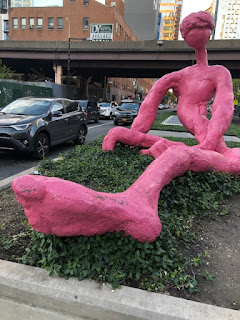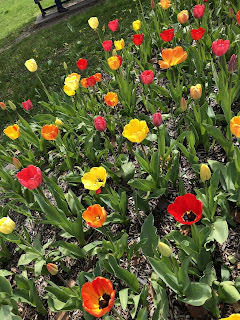Today I am going to take you to a city with an international airport named after a Beatle. To my knowledge, it's the only such city.
You may have guessed that city is Liverpool, England. Now I'll give you a clue as to which Beatle has the honor: Its mayor has said the time has come to be "as radical as possible."
Which member of the Fabulous Four are you most likely to associate with the word "radical?" John Lennon, of course.
All right, I admit that I took his quote just a little out of context. And, of course, I can't take you to Liverpool: Not even the airlines can do that right now. For that matter, there aren't many places the airlines can take you now.
But, as I used to tell kids for whom I did creative writing workshops, your imagination can take you anywhere. If you can imagine (There's another John Lennon word!), you can.
And, it seems that Mayor Joe Anderson is doing just that. He is pleased with the improvement of his city's air quality since the lockdowns began. More important, he imagines maintaining it. More important still, he understands what needs to be done in order to keep its skies the clearest they've been since the Industrial Revolution began.
Mayor Anderson has just green-lit 2 million GBP to improve cycling in the city by introducing up to 100 km of pop-up lanes. He gave his approval as the city has already begun a 45 million GBP redesign of the center city that includes 11 km of permanent bike lanes.
While that will make the city's center more bikeable and walkable in the long-term, the "pop up" lanes are intended, in part, to help in the city's recovery from the pandemic. It comes at a time when the UK Government is encouraging local councils to improve cycling and walking structure as public transport will be operating on very limited schedules due to social distancing guidelines.
All of this, it seems, comes from a recognition of a question I've raised about in a couple of recent posts: Of those who have taken up cycling during the pandemic, how many will continue once things return to "normal?"
As I have mentioned, during the 1966 and 1980 New York City transit strikes, some people cycled to work. But once subway and bus service returned to normal, they hung up, sold, gave away or discarded their bikes. I maintain that in 1966, few adults cycled in the US and there was no cycling infrastructure; by 1980, more adults pedaled but there was little infrastructure. On the other hand, after the 2005 transit strike, many new cycle commuters continued to ride to work and school, in part because there was more of a cycling culture--and more infrastructure--than existed during the earlier labor stoppages.
Mayor Anderson seems to recognize that some Liverpudlians who took up cycling or walking are enjoying favorable conditions, with far fewer motorized vehicles on the city's streets than one normally encounters. Once shops, offices and other workplaces, and schools, re-open, traffic volumes could creep back up to pre-pandemic levels. And once public transport returns to a full schedule, people will return to commuting on buses and trains. Some of the newly-minted cyclists and pedestrians could be enticed to continue walking and riding if there are spaces in which they feel safe while riding, and other infrastructure (bike repair stations?) to support them.
"The COVID pandemic has impacted our way of life beyond imagination but the challenges it has presented has also provided us with a once-in-a-lifetime opportunity to re-imagine how we use and travel within our cities," Mayor Anderson says.
"Imagine." "Reimagine." How appropriate for a city that named its airport after John Lennon.
(Thanks to regular commenter "Voyage of the Eye" for alerting me to this story.)
You may have guessed that city is Liverpool, England. Now I'll give you a clue as to which Beatle has the honor: Its mayor has said the time has come to be "as radical as possible."
Which member of the Fabulous Four are you most likely to associate with the word "radical?" John Lennon, of course.
All right, I admit that I took his quote just a little out of context. And, of course, I can't take you to Liverpool: Not even the airlines can do that right now. For that matter, there aren't many places the airlines can take you now.
But, as I used to tell kids for whom I did creative writing workshops, your imagination can take you anywhere. If you can imagine (There's another John Lennon word!), you can.
And, it seems that Mayor Joe Anderson is doing just that. He is pleased with the improvement of his city's air quality since the lockdowns began. More important, he imagines maintaining it. More important still, he understands what needs to be done in order to keep its skies the clearest they've been since the Industrial Revolution began.
Mayor Anderson has just green-lit 2 million GBP to improve cycling in the city by introducing up to 100 km of pop-up lanes. He gave his approval as the city has already begun a 45 million GBP redesign of the center city that includes 11 km of permanent bike lanes.
While that will make the city's center more bikeable and walkable in the long-term, the "pop up" lanes are intended, in part, to help in the city's recovery from the pandemic. It comes at a time when the UK Government is encouraging local councils to improve cycling and walking structure as public transport will be operating on very limited schedules due to social distancing guidelines.
All of this, it seems, comes from a recognition of a question I've raised about in a couple of recent posts: Of those who have taken up cycling during the pandemic, how many will continue once things return to "normal?"
As I have mentioned, during the 1966 and 1980 New York City transit strikes, some people cycled to work. But once subway and bus service returned to normal, they hung up, sold, gave away or discarded their bikes. I maintain that in 1966, few adults cycled in the US and there was no cycling infrastructure; by 1980, more adults pedaled but there was little infrastructure. On the other hand, after the 2005 transit strike, many new cycle commuters continued to ride to work and school, in part because there was more of a cycling culture--and more infrastructure--than existed during the earlier labor stoppages.
Mayor Anderson seems to recognize that some Liverpudlians who took up cycling or walking are enjoying favorable conditions, with far fewer motorized vehicles on the city's streets than one normally encounters. Once shops, offices and other workplaces, and schools, re-open, traffic volumes could creep back up to pre-pandemic levels. And once public transport returns to a full schedule, people will return to commuting on buses and trains. Some of the newly-minted cyclists and pedestrians could be enticed to continue walking and riding if there are spaces in which they feel safe while riding, and other infrastructure (bike repair stations?) to support them.
"The COVID pandemic has impacted our way of life beyond imagination but the challenges it has presented has also provided us with a once-in-a-lifetime opportunity to re-imagine how we use and travel within our cities," Mayor Anderson says.
"Imagine." "Reimagine." How appropriate for a city that named its airport after John Lennon.
(Thanks to regular commenter "Voyage of the Eye" for alerting me to this story.)































